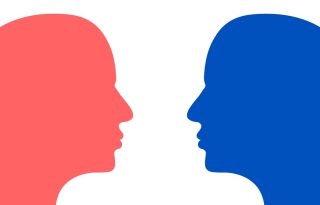Politics
How Social Identity Theory Explains Political Polarization
What can psychology tell us about the political divide?
Posted August 2, 2024 Reviewed by Tyler Woods
Key points
- Individuals derive part of their self-concept from their membership in social groups.
- Individuals adopt the identity of their political group, internalizing its norms, values, and behaviors.
- People compare their political group with others to maintain or enhance self-esteem.

Exploring political behavior and polarization through the lens of social identity theory (SIT) provides insights into how individuals' self-concepts are shaped by their group memberships, influencing their behaviors and attitudes toward in-group and out-group members. SIT elucidates the increasing polarization and hostility between political groups while also offering strategies to mitigate these divisive effects.
The power of SIT lies in its ability to explain how deeply ingrained political identities can drive division and conflict. For example, consider the political landscape in the United States. Democrats and Republicans often view each other not just as political opponents but as fundamentally different and opposing groups. This intense identification with political parties can lead to behaviors and attitudes that favor one's own group (the in-group) while discriminating against the opposing group (the out-group).
A vivid illustration of SIT's principles in action can be seen during election seasons. Campaigns and political advertisements frequently emphasize differences between parties, reinforcing group identities and exacerbating divisions. This approach not only mobilizes base supporters but also deepens the sense of "us versus them," leading to increased polarization and reduced willingness to engage in constructive dialogue.
The Foundations of Social Identity Theory
SIT posits that individuals derive part of their self-concept from their membership in social groups. These groups provide a source of pride and self-esteem, influencing behavior and attitudes towards both in-group and out-group members. In the political context, this translates into strong identification with political parties or ideologies, leading to behaviors and attitudes that favor one's own group (the in-group) and discriminate against opposing groups (the out-group).
Key Mechanisms in Political Polarization
- Social Categorization: People categorize themselves and others into groups. In politics, this often means identifying as a member of a particular political party or ideology. This categorization simplifies the social world and provides a framework for understanding political dynamics.
- Social Identification: Individuals adopt the identity of their political group, internalizing its norms, values, and behaviors. This can lead to a strong emotional attachment to one's political identity.
- Social Comparison: People compare their political group with others to maintain or enhance self-esteem. This often results in in-group favoritism and out-group discrimination, where one's own political group is seen as superior, and opposing groups are viewed negatively.
Partisanship as Social Identity
Partisanship has evolved into a core social identity for many individuals. This phenomenon, often referred to as "identity politics," means that political beliefs are closely tied to personal identity. As a result, people are more likely to view political affiliations as integral to who they are. This deep connection makes compromise and dialogue increasingly difficult, as any challenge to political beliefs is perceived as a personal attack.
Media Influence
Media consumption patterns play a significant role in reinforcing social identities. People tend to seek out and consume media that aligns with their pre-existing political beliefs, a behavior known as selective exposure. This tendency to favor partisan media intensifies in-group favoritism and out-group discrimination. By continuously consuming content that echoes their beliefs, individuals become more entrenched in their political views.
Group Threat and Political Behavior
When individuals perceive a threat to their political group, their responses can become more extreme. This perceived threat can lead to increased support for extreme policies and hostile behaviors towards out-group members. The sense of threat heightens in-group solidarity and amplifies the divide between groups. This dynamic is evident in various political contexts, where perceived threats—whether real or imagined—drive individuals to adopt more radical stances and view the opposition with heightened suspicion and hostility.
Strategies to Overcome Political Polarization
While the impact of social identity on politics can lead to deep divisions, several strategies can help mitigate its negative effects:
- Encouraging Superordinate Identities: Promoting a larger, inclusive identity that encompasses multiple groups can reduce in-group favoritism and out-group discrimination. For example, emphasizing a shared national identity over partisan identity can foster unity. Research supports this approach, showing that creating common ingroup identities can reduce intergroup bias.
- Promoting Intergroup Contact: Encouraging interactions between members of different political groups can reduce prejudice and increase understanding. Allport’s Contact Hypothesis (1954) suggests that under appropriate conditions, intergroup contact can diminish stereotypes and improve intergroup relations. Pettigrew and Tropp (2006) confirmed this through a meta-analysis, showing that intergroup contact generally reduces intergroup prejudice.
- Fostering Critical Media Consumption: Educating individuals about media literacy and encouraging diverse media consumption can help reduce the reinforcement of biased perspectives.
- Dialogue and Deliberation: Structured dialogues that encourage respectful conversation and deliberation across political lines can help bridge divides. Programs like “Living Room Conversations” and “Braver Angels” provide frameworks for such dialogues, promoting understanding and reducing animosity.
- Highlighting Common Goals: Focusing on common goals and values that transcend political divisions can create a sense of unity. For instance, initiatives that emphasize community service or shared economic interests can bring people together across political lines. Research supports this, showing that cooperation towards common goals can reduce intergroup hostility.
- Reducing Perceived Threats: Addressing the sources of perceived threats to political groups can reduce support for extreme measures and hostility. This can involve policy measures that ensure fair treatment and representation for all groups.
- Policy Interventions to Foster Civic Engagement: Governments can implement policies that promote active civic engagement and participation in democratic processes. Encouraging voter registration, providing platforms for public discourse, and supporting civic education can enhance the sense of belonging and shared responsibility among citizens.
Transcending the Divide
Social identity theory provides a powerful framework for understanding political behavior and polarization. By recognizing the mechanisms through which group identities influence attitudes and behaviors, we can develop strategies to reduce political divides. As we navigate the complexities of political identity, let us remember the words of Martin Luther King Jr.: "We must learn to live together as brothers or perish together as fools."
In embracing our shared humanity and striving for mutual understanding, we can transcend the divides that separate us.




